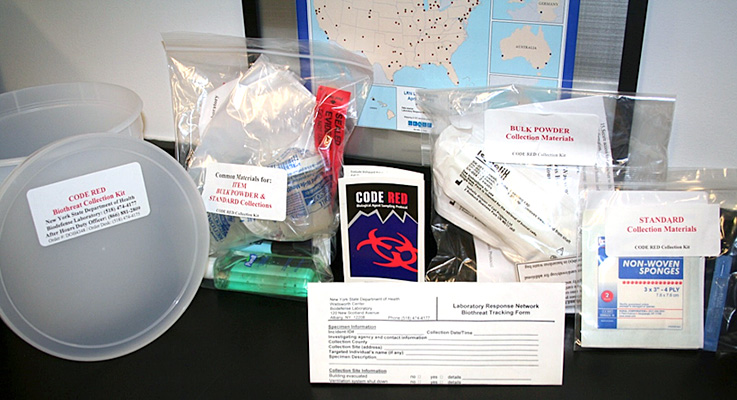Acceptable Samples – Credibility Assessment
All environmental biothreat samples, collected appropriately and packaged by a certified individual, must be analyzed by a New York State Environmental Laboratory Approval Program (ELAP) accredited testing facility.
Suspect biothreat specimens are considered legal evidence relating to non-accidental exposure to biological agents. The Wadsworth Center will accept approved specimens from law enforcement and first responder agencies following credible threat assessments. Material submitted as physical evidence must comply with the policies set forth to ensure appropriate chain of custody and specimen handling guidelines.
Refer to CODE RED quick-cards when assessing biothreat credibility.
- Was there a threat?
- Was there visible material?
- Was there an uncertain origin?
- Was there an exposure?
Collection
Collection of biothreat samples should be performed by informed and appropriately trained first responders following credible threat assessment. The decision to collect additional environmental samples for biothreat testing should be made with input from informed and appropriately trained medical, environmental, and industrial hygiene professionals familiar with the environmental sampling methodologies.

The Biodefense Laboratory has developed CODE RED kits to assist with submission of samples utilized by first responders for collections:
- The Wadsworth Center will accept approved specimens from law enforcement and first responder agencies following credible threat assessments.
- Collection kits which serve as a method of collection, packaging, and transport can be ordered from the NYS DOH order desk.
- Collection Kit Material
- Three (3) Sterile gauze swipes
- Three (3) Sample Containers with screw lid
- Three (3) Extra strength Hype-Wipes
- Four (4) Zipper seal baggies – 9”x12” size
- One (1) Red Biohazard bag
- One (1) Black sharpie marker
- One (2) 12.5ml water vial
- One (1) Code Red Card
- One (1) Annotated Collection Protocol
- One (1) Sample Tracking Form
- One (1) Collection Kit Contents & Reorder List
- A generalized “triple” (watertight primary receptacle, watertight secondary packaging, preferably a third watertight packaging and a durable outer packaging) packaging is required for a biological agent of human disease or materials that are known or suspected of containing them.
Shipping
Appropriately packaged Biothreat samples should be transported to the nearest approved LRN testing laboratory in the most rapid and expeditious manner while in the custody of the appropriate law enforcement agency. Law enforcement agents are exempt from federal Department of Transportation and International Air Transport Association packaging and shipping regulations and thus need not adhere to these regulations.
Transport of Biothreat samples by non-law enforcement officials:
Regulations on the transportation of biological agents are aimed at ensuring that the public and the workers in the transportation chain are protected from exposure to any agent that might be in the package. Protection is achieved through:
- The requirements for rigorous packaging that will withstand rough handling and contain all liquid material within the package without leakage to the outside
- Appropriate labeling of the package with the biohazard symbol and other labels to alert the workers in the transportation chain to the hazardous contents of the package
- Documentation of the hazardous contents of the package should such information be necessary in an emergency
- Training of workers in the transportation chain to familiarize them with the hazardous contents to be able to respond to emergencies
Evidence Receipt
The biothreat sample transporter will provide appropriate contact information to the designated representative via a chain of custody and a sample submission form.
- The package must be sealed with appropriate evidence tape and the tape must be initialed and dated.
- The tape must be affixed in a way that tampering would be obvious.
- A specimen submission form should be attached to the evidence container.